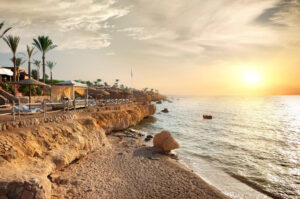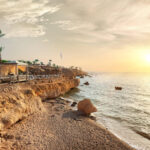Nestled at the foot of Mount Sinai, the monastery was built for Emperor Justinian between 527 and 565 AD. It later took the name of St. Catherine of Alexandria, whose remains are buried there. Today, the monastery houses a priceless collection of art pieces including religious ornaments, beautiful mosaics and a vast collection of illuminated manuscripts.
The Greek Orthodox monastery of the God-trodden Mount Sinai is located at the very place where God appeared to Moses in the Burning Bush, beneath the Mount of the Decalogue. In the providence of God, it is at this site also that the holy relics of Saint Catherine are enshrined. This is the oldest continuously inhabited Christian monastery, with a history that can be traced back over seventeen centuries. The monastery predates the divisions of the Christian world, its origins extending to late antiquity.
The monastery has never been destroyed in all its history, and thus it can be said to have preserved intact the distinctive qualities of its Greek and Roman heritage. Members of other Christian confessions have honoured the monastery, coming as pilgrims to this holy place. But from its beginnings, the Christian inhabitants of Sinai belonged to the Greek speaking world, and it has remained so to this day.
The earliest description refers to the Monastery of the Holy Virgin, for the revelation of God at the Burning Bush was seen as a type of the Virgin Mary and the Incarnation. The monastery is also especially dedicated to the holy prophets Moses and Elias, who both came to this mountain, and who both spoke with Christ at the Transfiguration. More recently, it has been known as Saint Catherine’s Monastery. This remains its name today, though the monastery has not lost its earlier dedications.
Spiritual Inheritance
More than one hundred and seventy Sinai saints are honoured by the Church. In addition to Saint Catherine, these include Saint John Climacus, abbot of Sinai and author of The Ladder of Divine Ascent. They also include the ascetic fathers Hesychios and Philotheus, two saints with the name of Anastasius, Gregory of Sinai (who transplanted the Hesychast traditions to the Slavic peoples), and Symeon Pentaglossos (who translated relics of Saint Catherine to Rouen, and thereby helped establish the veneration of Saint Catherine in the West).
The monastery can be thought of as a veritable Ark for its spiritual treasures. These include the manuscripts and early printed books preserved in the Sinai library, which is celebrated throughout the world for the antiquity and importance of its volumes. It also includes the monastery icons, which include the most important collection of pre-iconoclastic panel icons, and icons of the greatest beauty and significance dating from the time of the Comnene dynasty.
The monastery has been honoured by rulers throughout its history. These include the Empress Helena, the Emperor Justinian, Mohammed the Founder of Islam, Sultan Selim I, the Empress Catherine of Russia, and Napoleon Bonaparte. Contemporary heads of state have continued to show their interest in the monastery. The Holy Monastery of Sinai has been celebrated throughout the world for its spiritual and cultural radiance. It has been revered not only by Christians, but also by Moslems and Jews. It has recently been listed by UNESCO as a World Heritage Site, both for its cultural and for its scenic significance.
The monks of Sinai, from earliest times until the present day, maintain a dedication both to prayer and to the support of pilgrims and visitors. They live at peace with the native Bedouin. They maintain the ancient spiritual heritage of Sinai, a heritage that extends from the giving of the Law, through the whole of the Old and New Testaments, to the multitude of saints whose memory has been enshrined at Sinai – above all, to the All-holy Theotokos, to the holy prophets Moses and Elias, and to Saint Catherine.














